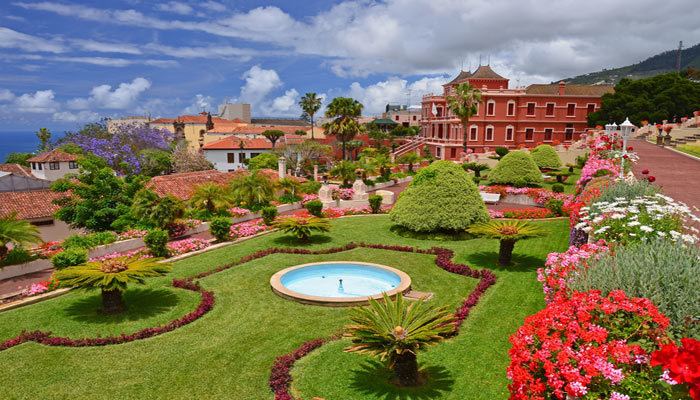Post Code 38300 | Time zone GMT (UTC+0) Climate Csb | |
 | ||
Weather 24°C, Wind S at 10 km/h, 21% Humidity University Universidad Europea de Canarias Points of interest | ||
La Orotava is a town and a municipality in the northern part of Tenerife, one of the Canary Islands of Spain. The area of the municipality stretches from the north coast to the mountainous interior, and includes the summit of the Teide volcano, Canary Islands' and Spain's highest point at 3,718 m. At 207.31 km2, it is the largest municipality of the island of Tenerife. The population is 41,255 (2013).
Contents
- Map of La Orotava Santa Cruz de Tenerife Spain
- Tenerife la orotava canary islands spain travel channel
- Toponymy
- History
- Economy
- Subdivisions
- Education
- Sites of interest
- Persons
- In literature
- References
Map of La Orotava, Santa Cruz de Tenerife, Spain
The town La Orotava, which is the administrative centre of the municipality and also its largest settlement, is situated near the north coast, at about 400 m elevation in the Orotava Valley. It is 4 km southeast of Puerto de la Cruz and 28 km southwest of the island's capital, Santa Cruz de Tenerife. The TF-5 motorway passes through the north of the municipality.
The coat of arms of La Orotava was adopted by Alfonso XIII in 1906, the dragoons escorting the drago and the tree of golden apples refers to the mythology of the Garden of Hesperides, believed was located in La Orotava. In gastronomy, La Orotava was honored for the Denominación de Origen Valle de La Orotava or the Denomination of the Origin of the Orotava Valley (Valle de La Orotava) in wines.
The historic center of La Orotava was declared Conjunto histórico in 1976 and is included in the Inventory of the European Cultural Heritage Protection and Monumental. Also noteworthy is that much of the Teide National Park (a World Heritage Site in 2007) is located within the municipality. La Orotava is also the highest town of Spain and steepest, the municipality comes from sea level up to 3718 meters the Teide (the highest peak in Spain).
Tenerife la orotava canary islands spain travel channel
Toponymy
It is not known with clarity which is the origin the name of the population, but the vast majority of researchers say it could be due to the situation of the town in the time of the Guanches, who called the area Arautaba or Arautápala. From the point strictly linguistic, Orotava voice belongs to a very advanced stage of deformation of the primary language Amazig, to the castilian.
History
The Guanches lived primarily in coastal areas and in the vicinity of the largest canyons and hillsides in the valley. In these places food and means of subsistence were easily found. For the Guanches, the highest peak in Spain (Mount Teide), which is situated on this township, was a place of worship.
On the arrival of the Spanish conquistadores, such as Alonso Fernandez de Lugo, the people of Tenerife resisted. Tenerife was the last of the Canary Islands to be conquered, in 1496.
The original population not suffered high mortality, for various reasons, such as to have been white, the assimilation of the Catholic religion, much like their traditions, and finally, the resistance to normal disease in Europe and North Africa.
Economy
The export economy established by the European colonizers after the conquest in the 15th century generated large commercial and passenger movements for decades. The first foreign visitors quickly felt drawn to the beneficial qualities of the weather in the Taoro Valley.
La Orotava has a rich land for cultivation and its economy was based on agriculture for centuries, with products such as wine, tomatoes, bananas and others that were exported mainly to Europe and the UK.
It was not until beginning of the 19th century when the tourism industry began. The environment of La Orotava meant that it attracted many researchers and exclusive high-class groups from Europe. At this stage La Orotava was a leading cultural center accommodating many travellers and writers, among others William Wilde and Alexander von Humboldt.
Currently, La Orotava is frequented all year by Northern Europeans, specially during the winter months, due to its mild climate, and is particularly popular over Christmas and the New Year periods.
Subdivisions
The Orotava Valley stretches from the sea up to the mountains at 2,000 m which begins near Las Cañadas up to Pico del Teide at 3,718 m is Spain's tallest mountain. The valley includes the municipalities of Los Realejos, Puerto de la Cruz and La Orotava.
La Orotava is subdivided in various locations, among others El Rincón, La Florida, La Perdoma, San Antonio, La Luz or Aguamansa.
Education
The British School of Tenerife has its La Luz Campus in La Orotava.
Sites of interest
Persons
In literature
The English author Christopher Isherwood describes completing his novel Mr Norris Changes Trains in La Orotava in the summer of 1934 in chapter 10 of his autobiography Christopher and His Kind.
The English author Radclyffe Hall in chapter 37, section 3, of her novel "The Well of Loneliness" has her character Stephen Gordon state to her love interest Mary Llewellyn,"I'd like to get you right away for a bit, the weather seems pretty awful in Paris. Puddle once told me about Teneriffe, she went there ages ago with a pupil. She stayed at a place called Orotava; it's lovely, I believe – do you think you'd enjoy it?"
